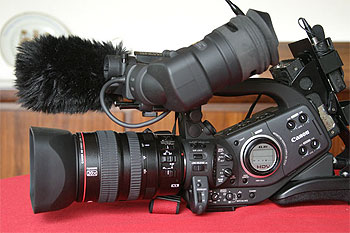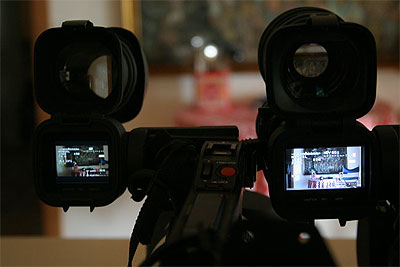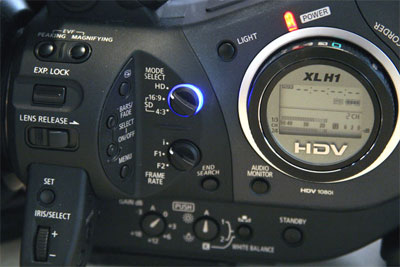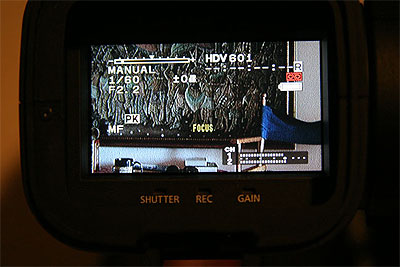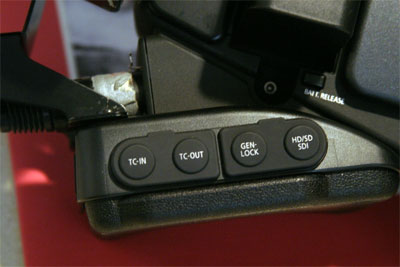 |
→ April 2006 Contents → Camera Corner
|
Camera Corner Review: The Canon XL H1
April 2006 |
 |
|||||||||||||||||||
|
Canon has always taken a "wait and see" attitude when it comes to introducing its new video products. Then, once it has determined the direction the market is going in, they do their homework, and come up with something that is beyond anything the competition has. Such is the case with the new Canon XL H1. Its predecessor, the Canon XL2, which we reviewed last year, was introduced in September of 2004 and had only been on the market for 18 months. JVC had already introduced their first HDV camcorder, which although The New York Times raved over it, was unworkable for any serious use. There was no editing software out there that could do anything with the result. It was more like a new toy. However, by that fall, Sony came to market with its Z1U, which was a knockout. This was a serious camera that could do 1080i HDV. Also, by that time Apple and other software manufacturers had come up with Codecs that allowed you to edit the tape. The camera quickly became a favorite with video journalists.
Well, it really wasn't about them. Canon had a different target in the cross hairs. They knew that thousands of broadcast and cable stations around the world had to upgrade to digital High Definition. This meant virtually all the old equipment had to go, and right away. However, the idea of buying $80,000 ENG cameras, to say nothing of replacing all the Beta editing bays in one fell swoop, caused every station manager to have a severe case of heartburn. So Canon thought, what if we could give them a camera that could stand up against the best ENG HD cameras, at one-fifth the cost? The math was simple and the argument persuasive. And then there was the motion picture industry. For the past five years, Hollywood has moved away from film to tape. Even people like George Lucas were using the Sony Cine Alta at a sticker price of $100,000. Then there were the new young independent filmmakers starting to produce their own films. And of course, there was always the porn industry in the San Fernando Valley. So the prosumers and VJs would have to wait a bit. THE CAMERA
The first thing you can't help but notice is that the viewfinder has become bigger. The LCD is now 1/2 inch bigger. The eyepiece can swing back to reveal a 2 1/2 inch LCD, which is great for shooting from a tripod or from low or high angles.
Once you power up the camera from the control dial on the side of the body, and look through the viewfinder your eyes will pop. Because pop is what the screen does. It is roughly three times as bright as the XL2. I placed the XL H1 and XL2 side-by-side and focused on an interior scene in subdued lighting. The difference in brightness and quality was amazing. Actually, the XL2, which I always thought looked just great, now seemed murky and too warm. The XL H1 image by contrast had the vivid cool colors, with true whites and blacks.
WARNING: THE VIEWFINDER ON THE XL-HI IS VERY BRIGHT. IF YOU RELY ON THE TONALITY OF THE VIEWFINDER IMAGE TO SET EXPOSURE, YOU WILL BE UNDEREXPOSING BY ABOUT TWO STOPS. IT WILL FOOL YOU. IN INTERVIEW SITUATIONS, USE OF A BROADCAST MONITOR IS RECOMMENDED.
Canon has designed a new lens for the XL H1, a 20X fluorite L-series lens. When shooting in the 16:9 mode, it actually duplicates the wide 20mm angle of their former wide-angle 3x lens. By adding a Century wide-angle adaptor, you can really open up a room.
On the side of the camera, next to the control dial, is the mode select in which you can select either HD (when you do, a blue light goes on around the selector switch), or standard HD, in either 16:9 or 4:3 aspect ratios. Below that, is the frame rate selector that allows you to choose 60i, 30p or 24p.
Most of the other control buttons are similar to the XL2; however, if you look right under the viewfinder, you will find a small selector switch that says "peaking" or "magnifying." This is a feature that was previously available only on professional ENG cameras. When focusing manually, my old eyes have always had a problem seeing precise focus, so I did what most cameramen do, I zoom in to the subject's eyes, get the speculars sharp, then pull out for the shot. With peaking engaged, when you hit the point of precise focus, the screen almost looks like it is solarized. You can't miss it. Then to make it even easier, rather than the zoom in, pull out system of focus, you can hit the magnifying switch, which essentially zooms in about 3x to make it even easier to find that sharp point.
Under the audio panel door, you have dials for the four separate stereo channel gain controls.
Like the XL2, the XLR inputs are built into the body at the rear of the camera.
If you turn the camera around, you will notice that underneath the XLR inputs is what they call a "jack pack." Again, this feature was only previously available on broadcast ENG cameras. Here you will find access for Time Code In, Time Code Out, Gen Lock and HD/SD SDI. Up until now this wasn't something most prosumers or VJs cared about, but in the broadcast environment they are vital features, which allows cameras to talk to each other, and to engineers in the truck or studio.
One other thing to mention. In the XL2, Canon sneakily did away with the "photo" button. This allows the user to grab still frames, which is useful when shooting inanimate object such as buildings or signs. In previous XLs this was achieved by capturing a frame, and replaying it over 10 seconds of rolling tape. The photo button has reappeared on the XL H1, but instead of being captured on tape, the image is captured on a memory card. It takes standard SD or MMC cards.
CONCLUSIONS
One problem, as of the time this review was written, is that at present there is no plug-in solution that will allow HD editing from the tape. Canon has been working with Apple for the past few weeks, and my guess is that by the NAB convention later this month, that problem will be solved. In the meantime you can shoot on HD, then bring it into your editing program as standard DV, and later take the final edit backup to HD in post.
There is no doubt that Canon has raised the bar much higher in the camcorder business with the XL H1; it has closed the gap between high-end prosumer cameras and broadcast cameras. This is a camera that a broadcast cameraperson can be comfortable with. It is heavy enough to give you back problems, which is what these people want. ("You're not really a professional broadcast shooter till you have your first herniated disc.")
However, this is not a camera for a backpack VJ or an ordinary videophile. It is just too heavy. This is meant for heavy-duty, hard-core (sic) professional use. If you are a filmmaker you can put those "prime" Panavision lenses on it, and the camera will do whatever you ask of it. However, if you are a Platypus, don't worry, Canon has some nice surprises coming to a store near you in the next few months.
DISCLAIMER: Canon video is a sponsor of the Platypus workshops and the Platypus Theatre on The Digital Journalist. They have no influence on editorial content in this magazine.
© Dirck Halstead
Editor and Publisher of The Digital Journalist
|
||||||||||||||||||||
Back to April 2006 Contents
|
|
